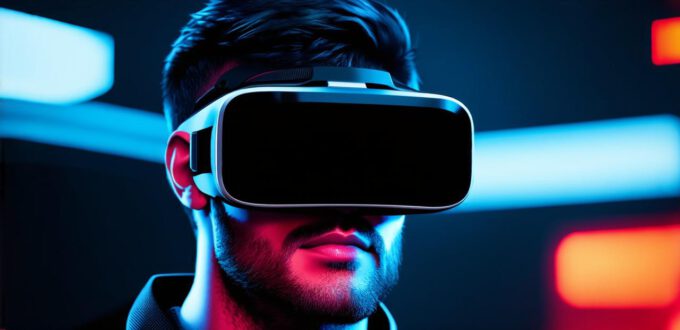Virtual reality (VR) is a rapidly growing technology that has the potential to revolutionize the way we interact with digital content. With the ability to create immersive and interactive experiences, VR applications are becoming increasingly popular across a wide range of industries, including gaming, education, and healthcare.
Understanding the basics of VR development
Before diving into the technical aspects of VR development, it’s important to understand the basic concepts and principles. At its core, VR development involves creating a virtual environment that users can interact with using specialized VR hardware, such as headsets or controllers. The goal of VR development is to create experiences that feel as realistic and immersive as possible, while also providing users with new ways to engage with digital content.
Some of the key considerations when developing VR applications include:
- Field of view (FOV): This refers to the width of the user’s visual field when using a VR headset. A higher FOV can provide a more immersive experience, but may also cause motion sickness in some users.
- Perspective and depth: VR applications should take advantage of the unique perspective and depth provided by VR hardware to create a sense of presence and realism.
- User input: VR applications must be designed to accept user input from specialized controllers or other devices, allowing users to interact with the virtual environment in a natural and intuitive way.
Choosing the right VR development platform
There are several VR development platforms available, each with its own strengths and weaknesses. Some of the most popular options include:
- Unity: A cross-platform game engine that supports VR development on a variety of devices, including PC, mobile, and consoles.
- Unreal Engine: A powerful 3D creation suite that includes built-in support for VR development, as well as a large community of developers and assets.
- A-Frame: An open-source platform for building VR experiences using HTML and JavaScript, with support for web-based VR experiences.
When choosing a VR development platform, it’s important to consider factors such as your level of experience, the complexity of your project, and the target devices you plan to support. Each platform has its own learning curve and set of tools and features, so it’s important to choose one that is well-suited to your needs.
Designing the VR environment
Once you have chosen a VR development platform, the next step is to design the virtual environment for your application. This involves creating 3D models, textures, and other assets that will be used to populate the VR space. Some key considerations when designing a VR environment include:
- Lighting and shadows: Proper lighting can help create a sense of depth and realism in a VR environment, while also highlighting important elements and providing contrast.
- Perspective and depth: As mentioned earlier, it’s important to take advantage of the unique perspective and depth provided by VR hardware to create a sense of presence and realism.
- User interaction: The virtual environment should be designed to allow users to interact with the digital content in a natural and intuitive way, using specialized controllers or other input devices.
Creating the VR experience
With the virtual environment designed, the next step is to create the VR experience itself. This involves writing code to control user interaction, handle physics and collision detection, and render the 3D graphics in real-time. Some key considerations when creating a VR experience include:
- User input handling: VR applications must be designed to accept user input from specialized controllers or other devices, allowing users to interact with the virtual environment in a natural and intuitive way.
- Performance optimization: VR applications must be optimized for performance, as slow load times or frame rates can cause motion sickness and negatively impact the user experience.
립>Physics and collision detection: The VR environment should be designed to simulate realistic physics and collision detection, providing a sense of realism and allowing users to interact with digital content in a meaningful way.
Testing and iterating on the VR application
Once the VR application is complete, it’s important to test it thoroughly to ensure that it works as intended and provides a positive user experience. This involves testing the application on different devices and platforms, as well as soliciting feedback from users and making adjustments based on their input. Some key considerations when testing and iterating on a VR application include:
- User feedback: It’s important to gather feedback from users to identify areas for improvement and make changes that enhance the user experience.
- Cross-platform compatibility: The VR application should be designed to work seamlessly across different devices and platforms, ensuring that users can access the content regardless of their hardware configuration.
- Performance optimization: Continuously optimizing the VR application for performance can help improve the user experience and reduce the likelihood of motion sickness.
Best practices for VR development
In addition to the technical considerations outlined above, there are several best practices that developers should follow when creating VR applications. These include:
- Keeping it simple: VR applications should be designed with simplicity in mind, avoiding unnecessary complexity and ensuring that users can easily navigate the virtual environment.
- Staying up-to-date: The VR landscape is constantly evolving, with new hardware and software releases on a regular basis. Developers should stay up-to-date with the latest developments and technologies to ensure that their applications remain relevant and cutting-edge.
- Iterative development: VR development is an iterative process, involving ongoing testing, feedback, and refinement. Developers should be prepared to make changes based on user input and continuously improve their applications over time.
Conclusion
Developing VR applications can be a complex and challenging process, requiring specialized skills and knowledge. However, with the right tools and best practices in place
